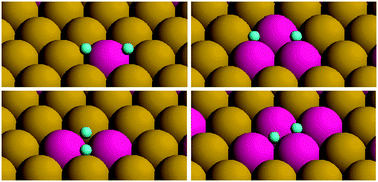Hydrogen adsorption on bimetallic PdAu(111) surface alloys: minimum adsorption ensemble, ligand and ensemble effects, and ensemble confinement
Abstract
The adsorption of hydrogen on structurally well defined PdAu–Pd(111) monolayer surface alloys was investigated in a combined experimental and theoretical study, aiming at a quantitative understanding of the adsorption and desorption properties of individual PdAu nanostructures. Combining the structural information obtained by high resolution scanning tunneling microscopy (STM), in particular on the abundance of specific adsorption ensembles at different Pd surface concentrations, with information on the adsorption properties derived from temperature programmed desorption (TPD) spectroscopy and high resolution electron energy loss spectroscopy (HREELS) provides conclusions on the minimum ensemble size for dissociative adsorption of hydrogen and on the adsorption energies on different sites active for adsorption. Density functional theory (DFT) based calculations give detailed insight into the physical effects underlying the observed adsorption behavior. Consequences of these findings for the understanding of hydrogen adsorption on bimetallic surfaces in general are discussed.


 Please wait while we load your content...
Please wait while we load your content...